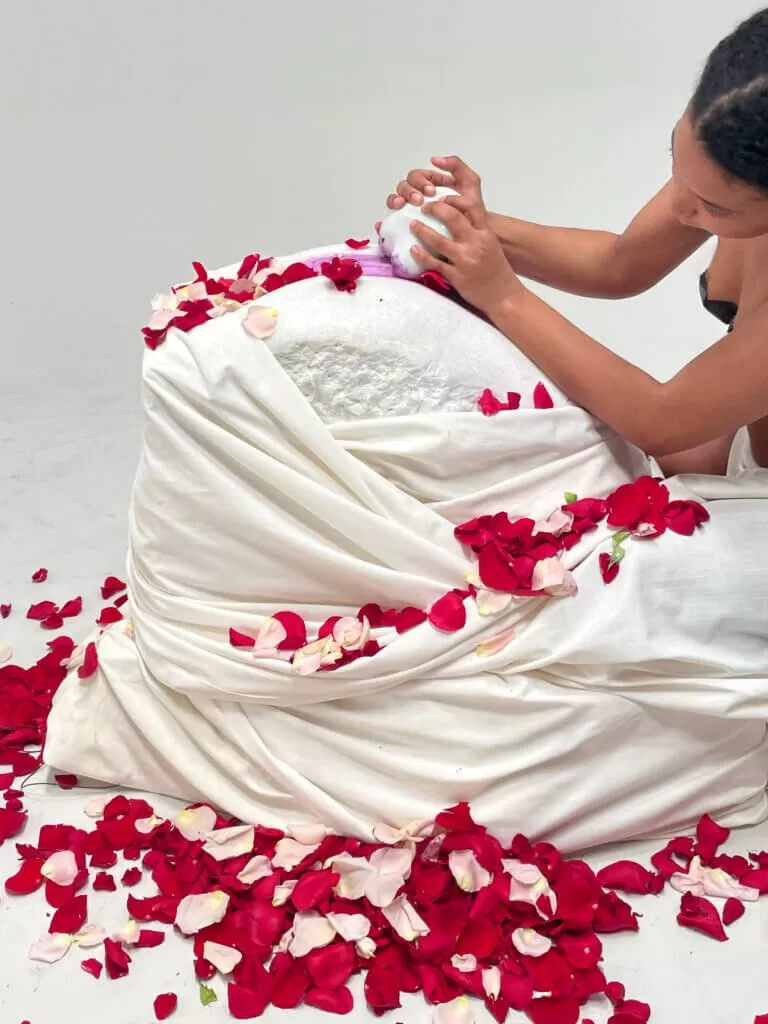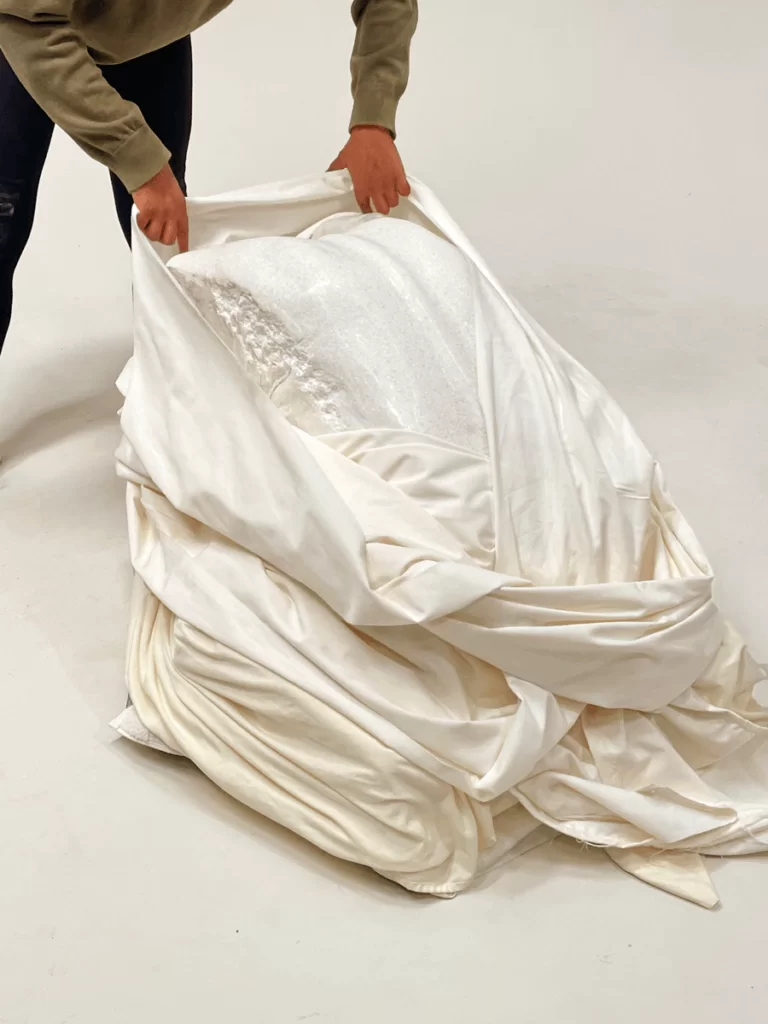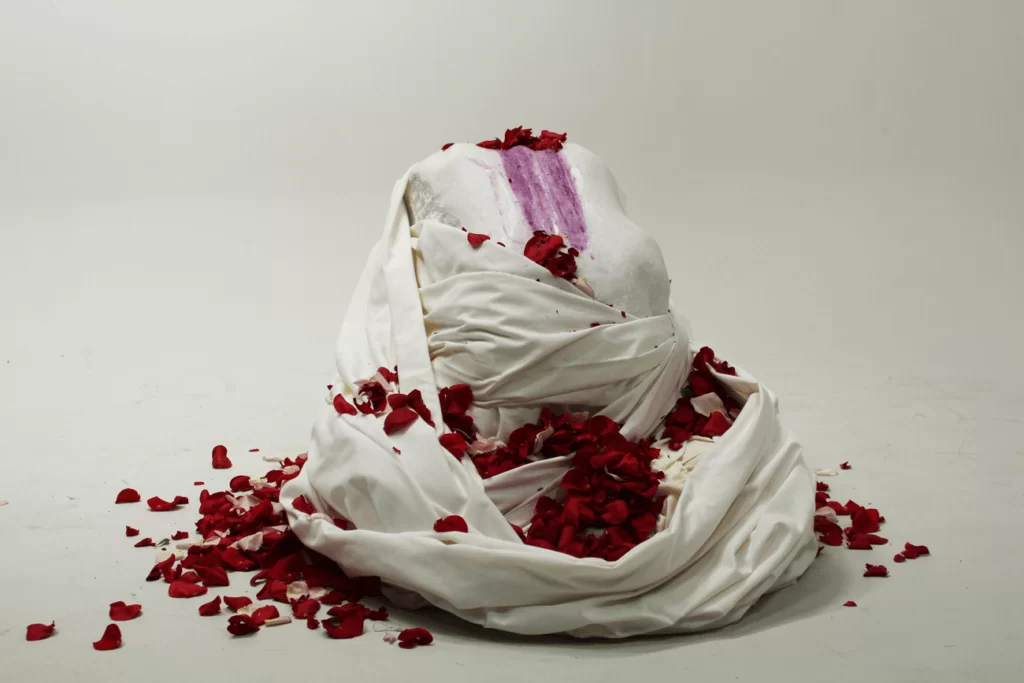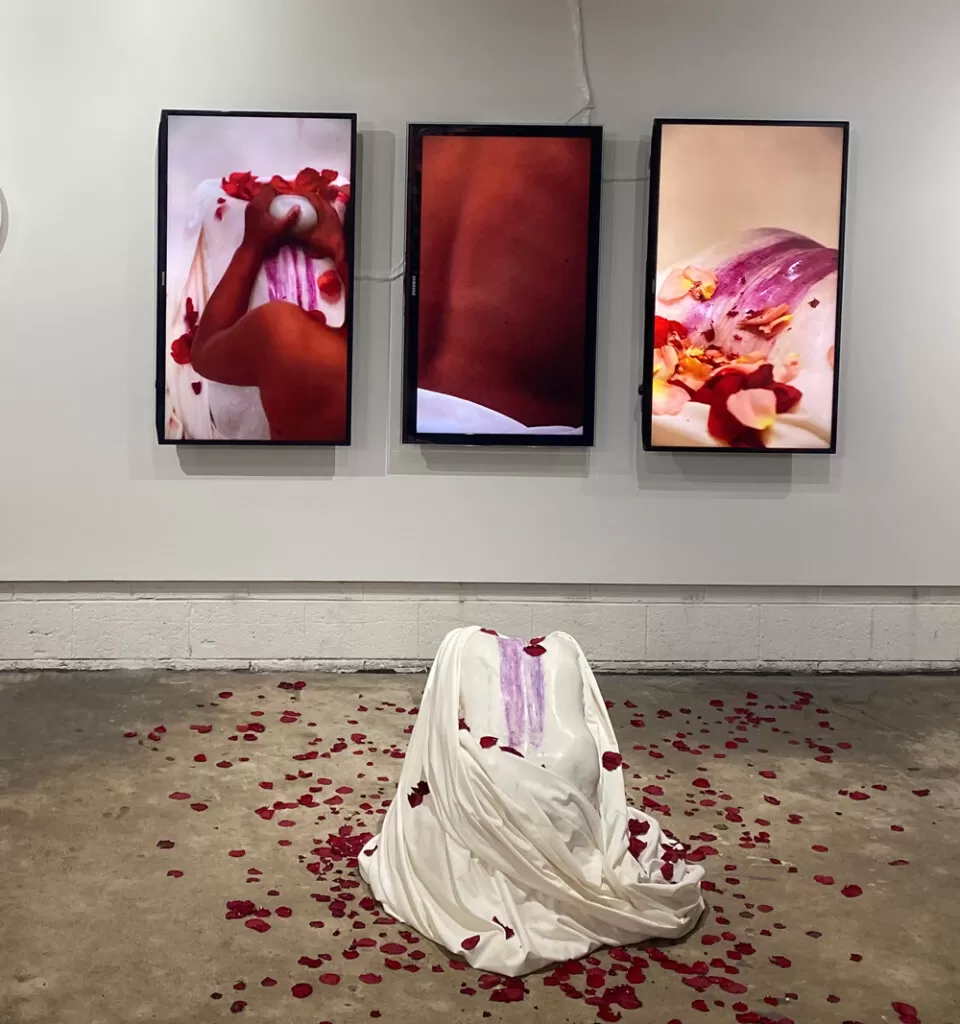Artist Maya Davis is a graduate of the College for Creative Studies. Over the past five years, she has been a practicing artist and educator in Detroit, Michigan. Davis’s practice is multi-disciplined, varying from painting, printmaking, and installation. Her work is focused on sculpture and experimenting with materials to depict notions surrounding love, care and sustainability.
In her most recent work, “The Giving of Taking”, Davis emphasises how physical and mental ability and illness can be contrasted with love and labour. Davis employed various materials in her work, ranging from multimedia to sculpture, analysing how these concepts can be intertwined.
The practice of labour in my work came out of me exploring what it meant to care for myself and my body and wanting to do better.
Maya Davis
These works comprise one part of a collaborative thesis with artist and fellow CCS student Sofia Bicego. Both artists explore similar territory, yet their practices are distinctive. In this thesis, we witness the harmonising of approaches as the artists delve deep into their subject matters.
I managed to catch up with Maya and Sofia to speak with them about their experiences studying at CCS and working together on their thesis. You can read Sofia’s interview by clicking here.
Q: Hi Maya, can you please introduce yourself for those who do not know?
A: Hi! I am Maya Davis, a recent graduate of the College for Creative Studies, where I majored in Fine Arts and Arts Education. I have been a practicing artist and educator for the past five years in Detroit, Michigan, and I’m originally from Lansing, Michigan. My practice is mostly comprised of sculpture and varying experimental materials, all conveying ideas surrounding love, care and sustainability.
Q: Can you tell us how you started in arts, how art has played a role in your lives, and why you decided to become an artist?
A: I actually spent a lot of my childhood thinking that I was going to go into a STEM field! I spent a lot of time in science and engineering clubs and activities, I’ve always had a passion for science, and I think that actually comes through in a lot of my art practice. So much of my work is extremely research-based, and I would say research is actually what takes up most of my time, and making follows suit usually much later.
I’m not sure exactly when my switch towards art happened, but probably once I started seriously looking into colleges. I started taking a few art electives and took solace in my art room and my amazing art teacher. As I went through some hard times and realized how much more at home, I felt surrounded by art people and got into painting (which I think most people did in high school).
I think my art teacher saw something in me and encouraged me to get conceptual with my work at a pretty early age, and he helped me realize that my art hobby could be more of a profession. I also started working as a studio technician for a ceramics studio in high school, and I had another fantastic mentor who opened my eyes to the world of sculpture. And I got to experience what it was like to work in an artist community, and it felt like home!
Q: As artists, both of your practices involve examining themes of physical and emotional labour and trauma and its impact on the physical body while using contrasting methods and media. Can you tell us more about your practice, inspiration and creative process?
A: Yeah! I love working with Sofia and talking about our work in a similar space because the themes tend to overlap beautifully. Labour is a huge part of my practice; all of my work takes months, if not years, to come to fruition and becomes a part of my life as I create it.
I think the practice of labour in my work came out of me exploring what it meant to care for myself and my body and wanting to do better. I think that struggle is prevalent in my earlier works about skins and backs and care practices, and it was a jumping-off point for me. As I look back, that work still holds so much value and meaning to me, and it was so terrifying to be so vulnerable in my work and have to talk about it and critique it, but it allowed me to understand myself in a new way.
As my practice has evolved, I’ve expanded this notion of care and labour. Much of my work focuses on the relationship between caring for others and caring for oneself and the sustainability and struggles that accompany that. I feel like I often take on a maternal role with my work, giving so much of my body, my time, and my emotions to a piece, and the piece doesn’t always give that much back, especially in the beginning.
As my practice has evolved, I’ve expanded this notion of care and labour. Much of my work focuses on the relationship between caring for others and caring for oneself and the sustainability and struggles that accompany that. I feel like I often take on a maternal role with my work, giving so much of my body, my time, and my emotions to a piece, and the piece doesn’t always give that much back, especially in the beginning.
This body of work that is featured is specifically touching on how much it takes to give, I have a chronic pain disorder which makes the things I do a lot harder, and they take a lot more out of me.
This thesis is also exploring and visualizing that when I am giving in anyway, I am giving so much of myself not only emotionally but physically. In making the sculpture, I could feel my joints grinding, my muscles aching, and my body wearing down just as the stone did to create the back that there is now. This practice isn’t something I can do forever as my illness takes my body over more, so having these works as homage and evidence to my love and practice is a beautiful archive of me for my future.
Q: You discuss the Physical Body as a Currency of Devotion in a body of work as part of your thesis at The College for Creative Studies (CCS). Can you tell us more about these works, their essence and their significance?
A: My work surrounding The Currency of Devotion explored just how much it takes to give, primarily focusing on the dynamic of romantic relationships. I often times find myself fascinated with how people have left their mark on me in various ways throughout my life. On my mind, my body and my lifestyle and even how I continue to interact with the world. Both for good and for bad. And, of course, I am interested in knowing how I have been left on other people, for better or for worse, how they remember me, and how my love impacted them.
This piece was crucial to me as I navigate how I share love. It’s not an easy choice to love somebody, right? And it’s also not always a choice, and I wanted to create a visual representation of this give and take of a relationship.
The idea actually came into fruition a couple of years ago now and has taken on many different physical forms, but I always knew that I wanted to follow a body’s curvature as a mortar and pestle. It only made sense to me to use a back as the body part to focus on, as it has been the focus of so much of my work in the past and the back is the center point of tension and the most expressive point of labor on the body.
This piece, as I stated earlier, is an archive of my labour and of my love and a performance of such. It is me putting my love on display and exploring what it all means in order to love fully and sustainably.
Q: The College for Creative Studies (CCS) provides students with the tools needed for successful careers in the dynamic and growing creative industries. Can you tell us more about the programme, what the experience was like and how it has contributed to your practice?
A: I chose CCS after debating and applying to a few different art schools! I really made the decision once I had toured the facilities, though. As a student who had never had much of an art room outside of a room with paint and a kiln, seeing such vast and large-scale studios made me fall in love with the school.
I was exposed to mediums that I never knew existed or were possible and wouldn’t have had the opportunity to explore without CCS. The curriculum of Art Practice is also extraordinarily vast and varied which is why I chose it. I was able to take classes in painting, printmaking, sculpture and more, as well as having a large amount of electives to hone certain skills further which was able to give me the most diverse education that I think I could have gotten.
I feel like my path at CCS was also very self-curated. I went through the art practice and art education departments somewhat out of order to make them all fit while working throughout the school year. But the ability to craft my curriculum in a very specific way was actually my favourite part about CCS. The flexibility in my studies and access to such large-scale industrial studios is definitely the reason that my practice is now so multi-faceted, and the support that I got from my professors and my peers to help my work critically and conceptually has truly pushed me to be at the point that I am now.
Q: The studio is the sacred temple of creativity. What are three things you can’t live without in your studio?
A: Haha, I have such an interesting relationship with my studio, and most of my studios have been in an academic setting, so I think I am still figuring out what exactly my practice and studio space looks like right now! But if I had to say three things. It would have to be a speaker/headphones for sure. I have such a hard time focusing when I don’t have music on in the background, and I also got really into podcasts when I was carving to help pass the time.
An extremely comfortable chair, I have a terrible back and also love to take breaks and having somewhere comfortable to rest from my work lets me stay in my studio way longer without pushing my body too far. A coffee/tea maker of some kind. For a long time, I would keep an electric kettle around and always had black tea from when I was doing work with Kombucha but in my last studio, my studio mate Alex had a coffee pot, and something about brewing a warm beverage makes making feel so much easier.
Q: In your opinion, what’s more significant, the story behind the work or the quality of the work itself?
A: For me it is definitely the story, I like to call myself a research-based artist because so much of the time spent making my work is online or in books, or in material research. My work also tends to look more simple and formal in its aesthetics, so much of the meaning lies in the love and labour behind it.
Behind almost each of my works are pages and pages of writing that don’t tend to make it to an exhibition or on a wall text and I actually battle with that quite a bit! I don’t really know if I need to justify my labour for the creation of the object or if it should just be inherent. I have been dabbling in video documentation as a way of dealing with this in my practice without having to put up a giant wall text or written material, and I can still allow the audience to come up with their own ideas and interpretation of how my labor shows itself in the work.
Q: What’s next for you as an artist?
A: I feel like that is such an interesting question for me at this point in my career. I am kind of at the intersection of a lot of things with my career and my practice, and I am trying them all until I see what sticks. I am finishing up an internship with The Whitney Museum in New York right now, where I am working in their school and educators’ partnerships departments, and I am planning on teaching within Detroit Public Schools in the fall!
I think that I am an artist who needs to have work or a career outside of my practice because my teaching and my museum inform my art so much. It is truly such a give and take, and right now, I am trying to figure out what career works best alongside my art practice while also feeding my soul in some kind of way.
As for my practice, I’m torn between many mediums and finding ways to do them all. Currently, I’m transitioning from the industrial studios at CCS to a studio out of my house. So I have been gearing my work to be on a smaller scale, which has been revisiting some of my bio material work like my SCOBY leather practice, continuing my silkworm project and seeing how I would be able to take that work into a fuller realization.
All of that to say, I have a lot of things planned and formulating in my mind, and I am so excited to see where they take me as I figure out the type of artist I am outside of an academic context.
Q: Lastly, what does art mean to you?
A: Art, to me… means expression. I love being able to walk into a gallery or a museum and am just taken aback by a piece, I get to jump into the crevices of an artist’s mind and see how their ideas and research and explorations relate to mine. It feels like I’m having a conversation with someone who could be a thousand miles away, and it’s so lovely to me.
I am someone that struggles a lot to get out some of my more complex ideas and emotions, and when I make work, it sometimes comes out without me even trying to. So it often gives me a visual language to explore some complex ideas that I haven’t been able to name otherwise.
©2022 Maya Davis









